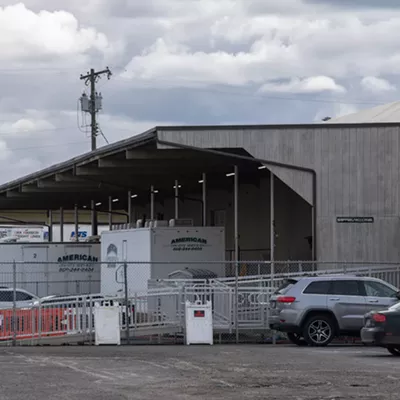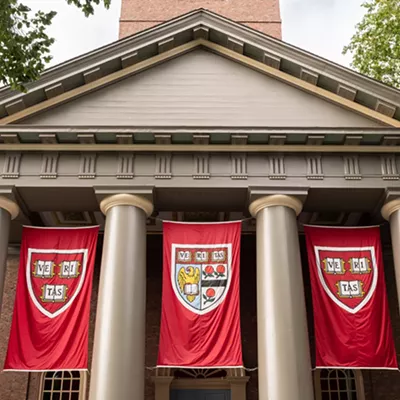Considered pests by some and pets by others, they come in many disguises and sizes. Some are big and bulky, sturdy even, suited for construction sites and pickup trucks and sitting in toolboxes. Others are sleek, petite, in playful colors, fitting snugly in an expensive leather purse. Some have e-mail, some have satellite tracking. They bingle and jingle, playing anything from the Star Wars theme to "Here comes Santa Claus" and "Stairway to Heaven."
Love them or hate them, cell phones are here to stay. That in itself may not be a problem if it wasn't for that one big and rather unsightly accessory they all come with: the cell phone tower.
Some towers look like badly designed, 60-foot artificial Christmas trees. Others are more straightforward, like tall antennae with a couple of discs attached here and there. Regardless of design, all towers have one thing in common: most homeowners would rather not have them looming over their fences.
When these towers seriously came into season, Spokane county and city administrators soon found themselves overwhelmed by complaints from property owners. "Not in my back yard" was the collective outcry, as the towers sprouted like mushrooms -- and kept growing.
About a year ago, both city and county invoked moratoriums on new cell towers, buying time to develop sufficient regulations. Now, by the end of January, both jurisdictions should be ready to adopt a set of rules that will let the towers stand -- but only when tightly regulated and in select locations.
One of the more outspoken critics of some already existing cell phone towers is Anson Avery, a certified public accountant with a South Hill office located right across the parking lot from a cell phone tower.
"We call them Frankenstein's children," says Avery. He's made a video documenting 10 cell phone towers in Spokane that he believes are on the wrong sites. "We are not opposed to all cell towers, just to the ones that are illegal. There's one on Northwest Boulevard and one here on 31st Avenue and Mt. Vernon."
The towers on Avery's video -- the big ugly transmission systems or "b.u.t.t.s." as he has dubbed them -- are all close to residential areas and family homes or in plain view from people's living room windows.
"The cell tower up here even violated the old rules," says Avery. "It's a 90-foot tower on a small lot, and it's too close to a residential house. And I don't believe it has all the permits it needs. It was put in about a year ago. Yes, I'm a neighbor and we have protested it; cell phone towers should not be inappropriately sited."
City planners admit that there have been some problems with the permit process, but insist that the tower on 31st Avenue has all needed papers appropriately filed and filled out.
"The one on 2600 W. Northwest Boulevard is a bit complicated. They got a permit to place a pole in the right-of-way and came back and asked to be able to put an antenna on it," says city planner Steve Haynes. "Planning found out after the fact that this was a cell phone tower. It's really unclear as to whether they were not aware or whether they avoided us. The property the tower is on is zoned for business, but it is close to a residential zone."
Avery has been "very vocal" according to several city and county officials, but he has also participated in the process of developing new regulations for cell phone towers through the Cell Tower Working Committee -- regulations the city council is expected to adopt by the end of January when the current city moratorium comes to an end.
But some cell phone towers have still been built during the moratorium. "It's been a partial moratorium, essentially," concedes Steve Franks, a city planner. "In residential zones [as opposed to commercial zones], there has been a complete moratorium."
Back when the moratorium was passed a year ago, the city council gave the Plan Commission the job of examining the existing permit process, then developing recommendations on how this process might change.
"We then created the working committee on cell towers, which identified some of the issues surrounding cell phone towers," says Franks. "Those issues were passed on to the Plan Commission, which then came up with the regulations. We have a draft written out and the final regulations are almost ready to go." The Cell Tower Working Committee, which consisted of four neighborhood representatives, four cell phone industry executives, one attorney, one engineer, three city staff members and two county staff members, produced a report which has already been presented both to the city council and to the board of county commissioners.
"Several public hearings and workshops have been held," says Franks, "so people have a had many chances to provide input on the new regulations."
The report makes several recommendations on how to regulate in a way that makes them less of an eyesore or a safety issue.
Among other things, the report recommends offering incentives to service providers if they choose to co-locate on an already existing tower, or build towers that are shorter or concealed from the surrounding area. Some cell phone towers have been hidden inside church steeples or other tall structures; these concealed sites are also known as stealth sites.
According to the draft regulations, cell phone towers would be permitted in all zones, provided that are attached to or inside of an already existing structure. They would also be allowed in nonresidential zones, provided that they are at least 300 feet from the nearest existing residential zone. In residential zones they could be allowed by special permit if located in the right-of-way, provided the tower is no taller than 60 feet and employs low visual impact technology.
The draft regulations also contain recommendations for fencing and landscaping to reduce the visual impact of the towers.
"The city council will see the recommendations in late December or early January, and we hope to get them adopted before the moratorium expires," says Franks. "There's been rumors that the moratorium would be extended, but if this happens, that will only be to cover the time gap between now and when the new regulations can take effect. Even when adopted as an emergency ordinance, it'll be 30 days before they take effect. In other words, either we'll have the new regulations or still have the moratorium."
Some attempts to regulate cell phone towers have been challenged in federal court, because some service providers claimed local jurisdictions were overstepping federal regulations by making it too difficult to find appropriate sites for new towers. About a year ago, U.S. West (now Qwest) complained that some cities in Washington state were trying to regulate the building of cell towers too tightly.
"At that time, the 9th Circuit Court of Appeals did throw out five of the regulations from five of the about one dozen cities," says Bob Beaumier, Spokane assistant city attorney. "But the 9th Circuit opinion is very broad. It gives us no details."
Beaumier adds that he feels the industry has been significantly involved in the development of these new regulations, and he doesn't expect any legal challenges once the city council approves the new regulations.
"To avoid litigation, it's essential to have good communication," he says. "I don't think there are any legal issues. The industry would have come forth and said something if they felt like we were overstepping our boundaries."
County planners follow the same guidelines from the Cell Tower Working Committee and hope to have their regulations in place almost as soon as the city.
"Our moratorium ends on May 5," says Esther Larsen, associate planner for Spokane County. "It took effect on February 13, 2001, and hopefully we'll have the new regulations ready and in place by February 13, 2002." The regulations are already written; all they need is the approval of the County Board of Commissioners.
She says the new regulations will demand that cell phone towers be placed at least one mile apart, and that rather than building new towers, service providers cohabit on existing ones.
The city and county have worked closely, not only in creating the work group but also in formulating the regulations.
"I think this may be the biggest undertaking we've been involved in, ever," says Larsen.
Franks adds that, from a planner's perspective the many different aspects that need to be taken into consideration -- zoning, placement, landscaping, height -- have made writing new cell tower regulations a big challenge.
"That's why it has taken so long," he says. He hopes the industry will be open to co-location on existing towers rather than just building new ones.
Earlier this year, Michael Broom, director of corporate communication for AT & amp;T Wireless, said that his company is very positive when it comes to the option of co-locating on existing cell towers.
"We are very supportive of co-location opportunities, provided those opportunities meet three criteria: they must be technologically feasible, practically feasible and economically feasible," he said.
The bottom line is that the cell phone market is so competitive that most service providers probably will comply with many regulations to stay in the local market.















